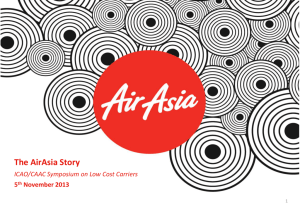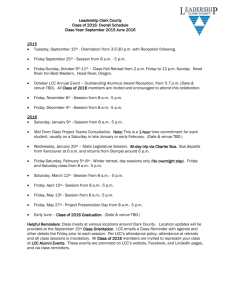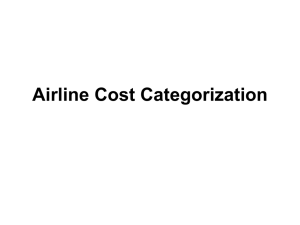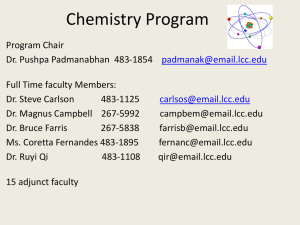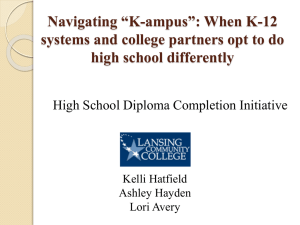AirAsia Airline
advertisement
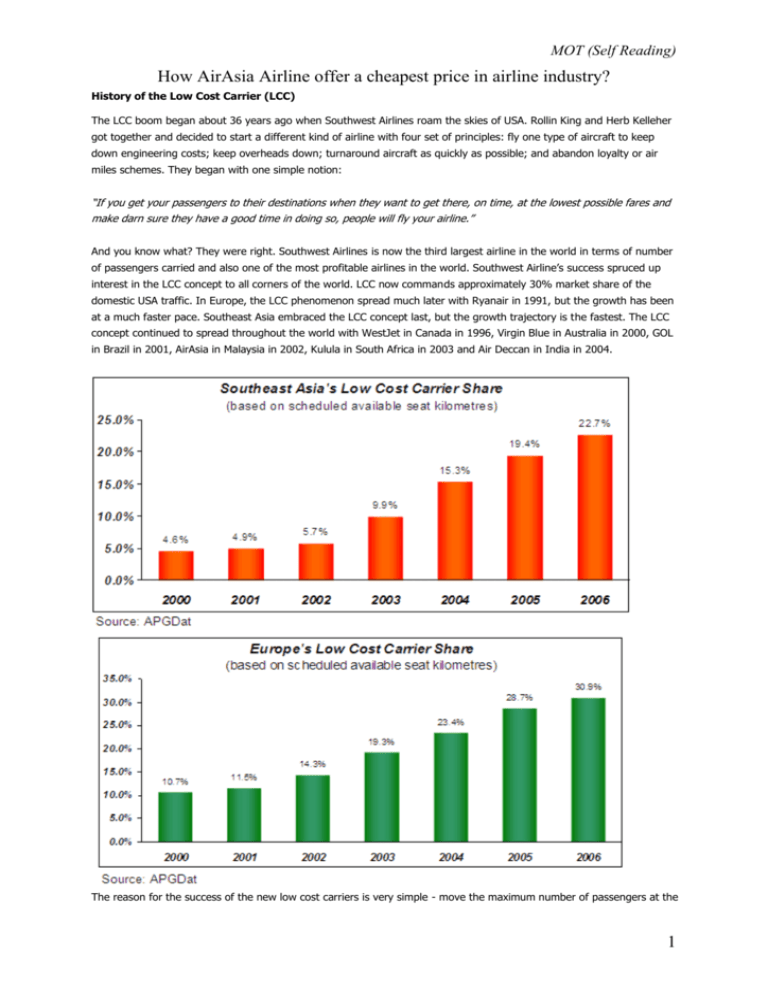
MOT (Self Reading) How AirAsia Airline offer a cheapest price in airline industry? History of the Low Cost Carrier (LCC) The LCC boom began about 36 years ago when Southwest Airlines roam the skies of USA. Rollin King and Herb Kelleher got together and decided to start a different kind of airline with four set of principles: fly one type of aircraft to keep down engineering costs; keep overheads down; turnaround aircraft as quickly as possible; and abandon loyalty or air miles schemes. They began with one simple notion: “If you get your passengers to their destinations when they want to get there, on time, at the lowest possible fares and make darn sure they have a good time in doing so, people will fly your airline.” And you know what? They were right. Southwest Airlines is now the third largest airline in the world in terms of number of passengers carried and also one of the most profitable airlines in the world. Southwest Airline’s success spruced up interest in the LCC concept to all corners of the world. LCC now commands approximately 30% market share of the domestic USA traffic. In Europe, the LCC phenomenon spread much later with Ryanair in 1991, but the growth has been at a much faster pace. Southeast Asia embraced the LCC concept last, but the growth trajectory is the fastest. The LCC concept continued to spread throughout the world with WestJet in Canada in 1996, Virgin Blue in Australia in 2000, GOL in Brazil in 2001, AirAsia in Malaysia in 2002, Kulula in South Africa in 2003 and Air Deccan in India in 2004. The reason for the success of the new low cost carriers is very simple - move the maximum number of passengers at the 1 MOT (Self Reading) minimum of cost. The concept of LCC is based on the idea that people would fly a lot more often if it were more affordable. LCC airline’s main mission is to make air travel the most simple, convenient and inexpensive form of transportation in the world. The fare differential between the full service carriers (FSC) and LCC can be as high as 40%60% cheaper. How LCC offer such low fares? The key to delivering low fares is to consistently keeping cost low. Attaining low cost requires high efficiency in every part of the business and maintaining simplicity. Therefore every system process must incorporate the best industry practices. The key components of the LCC business model are the following; 1. High aircraft utilization Aircraft is kept flying as much as possible, the first flight starts as early in the morning commercially possible and the final flight typically ends at midnight. A fast turnaround is critical to ensure time spent of the ground is minimal – an airline makes money when the aircraft is flying, not when the aircraft is parked. AirAsia’s turnaround time is 25 minutes; compare that against 1 hour for a FSC. On average, AirAsia’s utilization per aircraft is 12 block hours per day, a FSC might do about 8 block hours per day. 2. No frills The underlying business for a LCC is to get a person from point A to point B. Everything else is considered to be luxury item or “frill”, of which can be acquired for a small fee. Among many of the frills that AirAsia has do away are; No free food & beverages. Why give away something that you don’t appreciate? Passengers are most welcome to purchase food & drinks at an affordable price from the cabin crew. Free seating. There is no assigned seating. Passengers receive a generic boarding pass and they will have to take any of the available seats. Ticketless airlines. Less hassle for the customer, who doesn't have to worry about collecting tickets before traveling, and cost-effective for the airlines (paper, printing, distributing). No refund. Airlines waste a lot of money when passengers do not show up for a flight due to refunds and rescheduling. Whether a passenger shows up or not, the cost of flight to the airline is the same. LCC are unforgiving to no show passengers and do not offer refunds for missed flights. No loyalty programme. We believe our customers are loyal to our low fares, so who needs frequent flyer miles programme then. 3. Streamline Operations Making the process as simple as possible is the key of a successful LCC. AirAsia’s day to day operational principle is K.I.S.S (keep it simple stupid). Single type of aircraft. Pilots, flight attendants, mechanics and operations personnel are specialized in a single type of aircraft, which means, among others, that there is no need for costly re-training of staff, for maintaining a stock with parts for different types of aircraft, for knowledge and skills in order to operate and maintain different types of aircraft with their own characteristics, or for new work requirements. Single class seating. There is only one class seating, i.e first class, and passengers are free to sit where they choose. Should you want to have the privilege to choose your seats, you can by purchasing Xpress boarding. Standard Operating Procedures. SOPs are important to ensure same level of competence among all the staff. 2 MOT (Self Reading) This way we can ensure the homogeneity of service throughout the company. 4. Basic Amenities Secondary airports. Low cost carriers mostly fly to and from airports that are not necessarily the busiest, for example, London - Stanstead rather than London - Heathrow. These are often referred to as secondary airports. Operating from so called secondary airports is cheaper than from the bigger major airports and they are also a lot less congested and “turnaround times” for aircraft are a lot shorter. For instance, to minimize fees AirAsia fly into Clark Airbase which is 70km away from Manila as appose to flying into Manila Ninoy Aquino airport. Business Lounges. Forget about it. 5. Point to point network Point to point network. LCC shuns the hub-and-spoke system and embraces the simple point-to-point network. Almost all AirAsia flights are short-haul (3 hour flight or less). No arrangements have been made with other airline companies on connecting flights, on possibilities of flight transfers, nor on having the luggage labeled and passed through from one flight to another. 6. Lean Distribution System Distribution costs are something that FSC most often ignore. Very often, FSC relies on travel agents and from their posh sales office. Furthermore, FSC always blows the budget by complicating their distribution channels by integrating their systems with multiple Global Distribution Systems. LCC will keep their distribution channel as simple as possible and will cover the whole spectrum of the clientele profile. For example, AirAsia can cater to the most sophisticated European traveler via internet and credit card sales. And at the same time, AirAsia has an established system to sell our tickets to the most remote and technology deprived locations, such as in Myanmar. Internet Sales. The bulk of sales (±65%) are done via the airline’s website, whereby the fares are paid using a credit card. This is the most cost effective distribution channel. Sales office. AirAsia only has a few sales offices. We only establish a call centre if we are confident the sales derived from the centre will be worth it. Furthermore, we are not fixated with having our sales office in the posh side of town. Travel agents. LCC avoids reliance for sales via travel agent as much as possible. This means that the airlines do not pay any commission to a travel agent, which would otherwise have been reflected in the fares. Also, as they do not use travel agents, they do not use, nor participate in the world wide reservation systems and thus save costs, which again are reflected in their pricing. Call centres. Ticket sales can be done via telephonically; this is a simple and cost effective method. source (http://www.airasia.com/site/en/pageWithMenu.jsp?name=What%20Is%20Low %20Cost?&id=e0555498-ac1e00ae-3a5a9c00-8ddbf477&rootId=50ae1200c0a8c85d-1410a850-baad6a43&parentId=2ecd455d-c0a8c85d-177e6b40a7cb7dbc) [accessed on 23/09/09 2:35PM] 3

